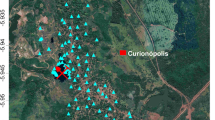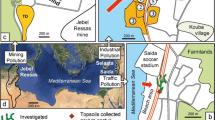Abstract
Six locations across mainland Portugal were selected for exposing Parmelia sulcata, for a one-year period (8 months for one site), with simultaneous measurement of total (dry + wet) deposition (one-month periods). The exposed lichens and the total (dry + wet) deposition were analysed for cobalt contents by INAA (instrumental neutron activation analysis) and ICP-MS (inductively coupled plasma mass spectroscopy), respectively. The designated “wet” deposition was evaluated through the collected water volume; the designated “dry” deposition was assessed after the (dried) residual mass of the “wet” deposition. An excellent agreement between Co contents in exposed lichens and the cumulative (1) Co contents in the “dry” deposition, (2) “dry” deposition, and (3) “wet” deposition has been found for the locations with alternate drought and precipitation months, high “dry” deposition, and high Co contents in the latter. Continuous rainfall was found to hinder the Co accumulation in the lichen due to its release from the lichen and/or lower Co contents in the “dry” deposition. At three locations, P. sulcata Co contents, after subtraction of the background (before exposure), equalled or exceeded the Co contents in the cumulative “dry” deposition at the end of the exposure time. The optimal exposure period for this species likely depends on the exposure conditions.
Similar content being viewed by others
References
Backor, M. and Zetikova, J., 2003: Effects of copper, cobalt and mercury on the chlorophyll content of lichens, Cetraria islandica and Flavocetraria cucullata, J. Hattori Botan. Lab. 93, 175–187.
Carreras, H. A. and Pignata, M. L., 2002: Biomonitoring of heavy metals and air quality in Cordoba City, Argentina, using transplanted lichens, Environ. Poll. 117(1), 77–87.
Cerkasov, V., Pantelica, A., Salagean, M., Caniglia, G., and Scarlat, A., 2002: Comparative study of the suitability of three lichen species to trace-element air monitoring, Environ. Pollut. 119(1), 129–139.
Daillant, O., Beltramo, J. L., and Tillier, C., 2003: Lichens as bio-monitors of trace-elements in Central and Eastern France, J. Phys. IV 107, 349–352.
Freitas, M. C., Farinha, M. M., Pacheco, A. M. G., Ventura, M. G., Almeida, S. M., and Reis, M. A., 2005: Atmospheric selenium in an industrialized area of Portugal, J. Radioanal. Nucl. Chem. (in press).
Freitas, M. C. and Martinho, E., 1989: Accuracy and precision in instrumental neutron activation analysis of reference materials and lake sediments, Analytica Chimica Acta, Short Communication 223, 287–292.
Freitas, M. C. and Nobre, A. S., 1997: Bioaccumulation of heavy metals using Parmelia sulcata and Parmelia caperata for air pollution studies, J. Radioanal. Nucl. Chem. 217(1), 17–20.
Freitas, M. C., Reis, M. A., Alves, L. C., Wolterbeek, H. Th., and Gouveia, M. A., 1996: Elemental accumulation in lichen transplants in the neighborhood of thermal power stations, TANSAO 74, 117–118.
Freitas, M. C., Reis, M. A., Alves, L. C., Wolterbeek, H. Th., Verdurg, T., and Gouveia, M. A., 1997: Monitoring of trace-element air pollution in Portugal: Qualitative survey, J. Radioanal. Nucl. Chem. 217(1), 21–30.
Freitas, M. C., Reis, M. A., Marques, A. P., and Wolterbeek, H. Th., 2000: Dispersion of chemical elements in an industrial environment studied by biomonitoring using Parmelia sulcata, J. Radioanal. Nucl. Chem. 244, 109–113.
Freitas, M. C., Reis, M. A., Marques, A. P., and Wolterbeek, H. Th., 2001: Use of lichen transplants in atmospheric deposition studies, J. Radioanal. Nucl. Chem. 249(2), 307–315.
Garty, J., Levin, T., Cohen, Y., and Lehr, H., 2002: Biomonitoring air pollution with the desert lichen Ramalina maciformis, Physiologia Plantarum 115(2), 267–275.
Godinho, R. M., Freitas, M. C., and Wolterbeek, H. Th., 2004: Assessment of lichen vitality during a transplantation experiment to a polluted site, J. Atmos. Chem. (this volume).
Kabata-Pendias, A. and Pendias, H., 1984: Trace Elements in Soils and Plants, CRC Press, Inc., Boca Raton, Florida, pp. 241–245.
Loppi, S., Nelli, L., Ancora, S., and Bargagli, R., 1997: Accumulation of trace elements in the peripheral and central parts of a foliose lichen thallus, Bryologist 100(2), 251–253.
Loppi, S., Pirintsos, S. A., and De Dominicis, V., 1999: Soil contribution to the elemental composition of epiphytic lichens (Tuscany, central Italy), Environ. Monit. Assess. 58(2), 121–131.
Marques, A. P., Freitas, M. C., Reis, M. A., Wolterbeek, H. Th., and Verburg, T., 2004a: MCTTFA applied to differencial biomonitoring in Sado estuary region, J. Radioanal. Nucl. Chem. 259(1), 35–40.
Marques, A. P., Freitas, M. C., Reis, M. A., Wolterbeek, H. Th., Verburg, T., and de Goeij, J. M. M., 2004b: Biomonitoring-transplants in the assessment of the dispersion of atmospheric pollutants: Effects of positioning towards wind direction, J. Atmos. Chem. (this volume).
Marques, A. P., Freitas, M. C., Wolterbeek, H. Th., Verburg, T., and de Goeij, J. M. M., 2004c: Cell membranes damage in transplanted Parmelia sukata lichen related to ambient SO2 temperature and precipitation, Environ. Sci. Techn. (in press).
Reis, M. A., Alves, L. C., Freitas, M. C., Van Os, B., de Goeij, J. M. M., and Wolterbeek, H. Th., 2002: Calibration of lichen transplants considering faint memory effects, Environ. Pollut. 120, 87–95.
Reis, M. A., Alves, L. C., Freitas, M. C., Van Os, B., and Wolterbeek, H. Th., 1999b: Mean annual response of lichens Parmelia sulcata to environmental elemental availability, Sci. Total Environ. 232, 105–115.
Reis, M. A., Freitas, M. C., Alves, L. C., Marques, A. P., and Costa, C., 1999a: Environmental assessment in an industrial area of Portugal, Biol. Trace Elem. Res. 71/72, 273–280.
Rodrigo, A., Avila, A., and Gomez-Bolea, A., 1999: Trace element contents in Parmelia caperata (L.) Ach. Compared to bulk deposition, throughfall and leaf-wash fluxes in two oak forests in Montseny (NE Spain), Atmos. Environ. 33(3), 359–367.
Yao, H. and Ramelow, G. J., 1997: Evaluation of treatment techniques for increasing the uptake of metal ions from solution by nonliving biomass derived from strains of lichens, Sphagnum (peat) moss, and Eichhornia crassipes (water hyacynth) root, Microbios 97(363), 97–109.
Author information
Authors and Affiliations
Corresponding author
Rights and permissions
About this article
Cite this article
Freitas, M.C., Pacheco, A.M.G. Bioaccumulation of Cobalt in Parmelia sulcata. J Atmos Chem 49, 67–82 (2004). https://doi.org/10.1007/s10874-004-1215-x
Received:
Accepted:
Issue Date:
DOI: https://doi.org/10.1007/s10874-004-1215-x




